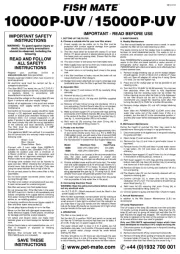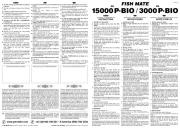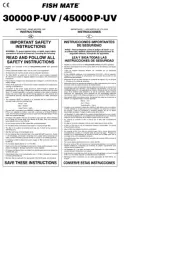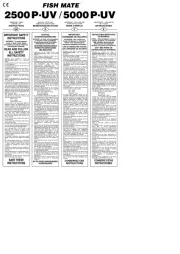
6.1 Pull out the rubber stopper, adjust float
so that it is18 to 22 cm from the sensor, or
at your desired depth.Replace the rubber
stopper by pressing it firmly into the float.
The Sensor float must be adjusted so that
it is a minimum of 18 cm away from the
6.2 Toss the sonar sensor and float assembly into water at your
desired fishing location.To toss, place the sonar sensor and float in
your hand, and pitch underhand. Do not throw the sensor by the
cable as this will cause unrepairable damage. Before tossing, be
certain that the cable is free from tangles and is not wrapped around
6.3 Your fish finder includes a combination
adapter, mounting bracket for the sonar
sensor.The Adapter includes mounting taps
so that you can attach it to any flat surface
or boat hull and appropriate rod, The Adapter
is removable and adjustable up to 180
6.4 Use a pole to guide the sonar sensor to a desirable position or
add floats on the cable to float on the water.
NOTE:*Incorrect to use : Do not allow the cable to sink to the
bottom as it may become entangled in debris.
* The float can be removed as follows, If you do not need it,
cutting off the rubber stopper from the cable and sliding the
safety strap and the float towards the plug and gently take it out
7 FISHING AT THE BOAT OR ICE
7.1.1 Toss the sensor and float into the water as per the previous instructions.
7.1.2 Attach the adapter to the boat hull using the mounting tabs.
7.1.3 “shoot –Thru” the hull of a boat.
Place the sonar sensor in 1 inches of water against the hull bottom.
Or coat the face of the sonar sensor with petroleum jelly and press it
against the hull bottom with a twisting motion.
7.1.3if it still doesn't work on all hulls and you may have to place the
sensor directly in the water for proper operation.
NOTE: If depth readings appear as "---" while using one of these
methods, place the sonar sensor directly in the water to verity
that the fish finder is operating properly. If it operates properly
while directly in the water, reposition the sensor in a new location
in the hull, and repeat the methods in above
To achieve the best performance for ice fishing, it is highly recommended
that you cut a hole through the ice and place the sonar sensor directly
in the water.If you would like to check the area for depth or fish before
cutting the hole. Clear away snow to expose the ice surface, making
sure the surface is smooth. Place a small amount of liquid water on the
ice and set the sonar sensor on the water, allowing the unit to freeze
If there are any air pockets between the sonar senor and ice, or air
on the water below the ice, the unit will not work properly and will
require you to try another spot, or cut a hole in the ice to use.
NOTE:* To remove the sonar sensor from the frozen gently tap
sonar sensor at the base with your hand. If it will not come loose,
spray a small amount of water on the ice surface around the base
and repeat above step until the sonar sensor is easily removed.
Never use a blunt to strike the sonar sensor as this may cause
damage to the sensitive internal electronics.
* Cold weather is extremely hard on the electrical components
within the display housing. It is suggested that you keep the
unit in temperatures above -17 degrees Celsius during operation.
*Remove the batteries from the fish finder to prevent battery
leakage and corrosion.Clean the sonar sensor and cable with
fresh water and dry-off before storing .Do not submerge and/or
spray the fish finder screen/housing with water or use chemicals
Depth Capability: 328feet(100m)
Sonar Coverage: 45 degrees beam angle in 200Khz
Power Requirement: 4xAAA alkaline batteries
Waterproof design: level-4 (spray-water-proof)
Show large and small fish, water depth, water temperature, air
temperature, air pressure, fish location, and bottom grass & rock
User selectable sensitivity, depth units, and fish alarm setting
Built in memory stores sonar setting when the fish finder is turned off
Operational Temperature: 14°F to 122°F(-10°C to 50°C)
1)Round Transducer with 8m Cable
We are really appreciated that you purchase our products!
In order to make the users give the machinery performance
into full play and well utilize this machine, we are pleased to ask
the users to read the operating instruction carefully before
operating the machine. If you have any question in use, please
feel free to contact the Zhejiang lucky Manufacturer Co.,Ltd for
consultation: WWW.LUCKYSONAR.COM
Sonar technology is based on sound waves.
The system uses sonar to locate and define
structure, bottom contour and composition,
as well depth directly below the transducer.
The transducer sends a sound wave signal
and determines distance by measuring the
time between the transmission of the sound
wave and when the sound wave is reflected
off an object; it then uses the reflected signal
to interpret location, size, and composition of
This amazing product is especially
designed for amateur and professional
fishermen alike, to findout the location
of fish and depth of water.The unit can
be used in ocean, river or lake and is
fantastic for datecting schools of fish in
Using amazing and innovative technology, this portable fishfinder is
the ideal toolto bring the fish toyou!
Slide and remove the Battery Door, lnstall 4 AAA batteries. Be certain
to align the batteries as per the diagram within the battery compartment.
Close the battery door completely.
1.Mode menu 2.Left menu 3.Setup menu
4.Right menu 5.Power ON/OFF
Press the POWER key to turn the power On , the unit enter normal mode
after display full show 1 second. Press and Hold the POWER key for 3
seconds to turn the Power Off. To enter the simulation mode: press and
hold the POWER key for 5 seconds and release while the power is off.
NOTE: The unit must be turned off to enter normal operation
Automatic power off feature : The display will shut off
automatically when the depth display reads "---" continuously
Press and Hold the SETUP key for 3 seconds, Water depth unit
{ FT } will blink; then pressing the SETUP key again and again, the
indicator will blink from the current feature to be set.
Water depth unit { FT } --- Sensitivity{ } ---Water temperature unit
---Air temperature unit--- Alarm{ }.
Press the POWER key to turn the power On , the unit enter normal
mode after display full show 1 second.
Press Mode menu to select mode among General mode, Shallow
mode, Slope mode, Raft mode, and Ice-fishing mode.
NOTE: The screen can be refreshed by pressing the POWER
key during normal operation.
If the finder determines that sonar has detected a fish,the display will
show a fish shaped icon. It can detect large fish and small fish.The first
column of fish indicators on the right of the display shows the most
current information. This column is then moved to the left as a new
reading is displayed Fish icon moved in every 5 seconds.
The depth readout on the top right, will appear after the power is
turned ON and the sonar sensor is placed in water. The depth meter
will indicate”---” if the depth exceeds these parameters.
NOTE: This reading may also occur in water is extremely dirty,
or where there are heavy silt or mud bottoms. Sonar is a sound
signal that travels through water. Sonar will not travel through air.
Keep this in mind when using the fish finder, as the smallest
bubble between the sonar sensor and the water, will cause the
unit not to operate correctly.
NOTE: The fish indicators move away from the right to the left
at a constant speed. This motion in no way reflects actual
Use the fish Depth lndicator to
measure the fish’s depth from
the sonar sensor.This can be
done by dividing the depth
reading by 10. This number
represents the value of each
(Example, the depth is 20 m, the fish symbol appears in the 5th box
from the top. This means the fish is 10 m from the surface)
The display indicates the presence of short weeds by turning on the
smallest Weed indicator (a) Moderately tall weeds are depicted by
turning on the second Weed indicators(b) Tall weeds are depicted
by turning on the third Weed indicator(c)
One Rock lndicator identifies limited structure(d) You would most likely
find a small rock, a small pile of rocks, or uneven bottom contour.
This is not a bad place for hiding fish, but due to the limited amount
of strucrure, there may not be a lot.
Two Rock lndicators identifies a considerable amount of bottom
structure, but scattered(e) A considerable amount of time needs
to be spent fishing this area as each piece of structure could be
hiding a prize catch.Three Rock lndicators indicates a large amount
of bottom structure in a confined area. This bottom may consist of
a large rock(s), stump(s), tree(s), or a ledge(s)(f)




















